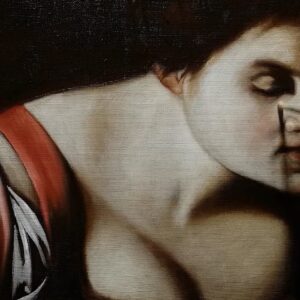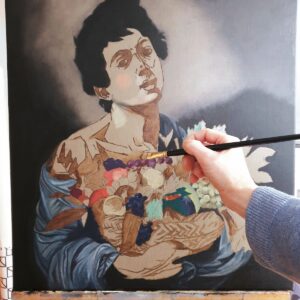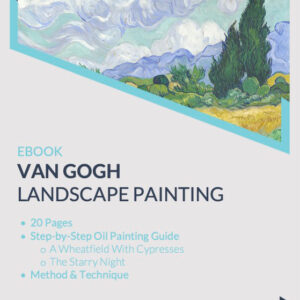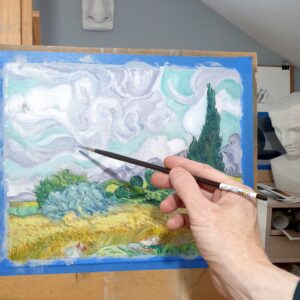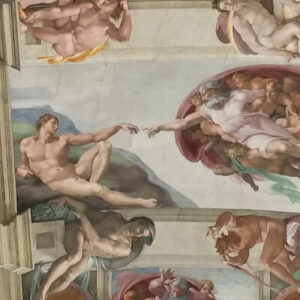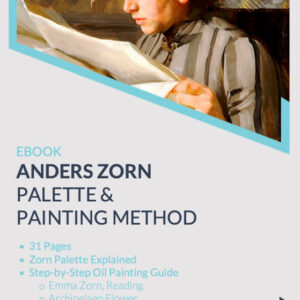Oil Painting Techniques PRO Online Course
€250.00 – €400.00Price range: €250.00 through €400.00
Contemporary painting practices with reference to historical styles and techniques.
ONLINE PAINTING COURSE
Registration is now open.
| Dates | 18th September – 11th December 2025 |
| Duration | 12 weeks (with a one-week break at Hallowe’en) |
| Time | Thursdays, 7 – 9pm (UTC+1) |
| Format | Live-Streamed & Recorded Online Course with exclusive content from Italy |
| Medium | Oil Paint |
| Level | PRO Intermediate – Advanced (Basic knowledge and experience in oil painting required) |
| Full Course Price | € 400 |
| Half Course Price | € 250 (You can book the second half of this course at any time for € 150) |
Still not sure? Why not join my FREE PREVIEW LESSON for this course on Thursday 21st August 2025? Register here
Join me online to learn the methods, techniques and traditions that inspire and underpin oil painting practices today, with exclusive bonus content from Italy.
The main focus of this course is on technique, specifically brushwork or the application of oil paint and how it affects and largely determines style. As such, you will learn about the early use of different brushwork techniques and how they are used today. You will be shown nine different approaches to paint application. How we apply paint to a support (canvas, board, etc.) involves the additional study of methods, pigments, mediums and tools, and you will be given a deep understanding of the properties and usages of each, both historically and presently.
The driving forces behind all of this technical know-how are bigger principles and aesthetics which vary from one period to the next, as well as the messages that artists want(ed) to convey. The role and treatment of drawing, colour, value and other pictorial elements will also be explained from various perspectives. Primarily, we will be painting the human figure and the portrait but we will also refer to still life and landscape genres.
This online course is packed with exclusive bonus content including painting videos on location around Italy, behind-the-scenes footage from museums, research departments and production facilities, and much more.
All live online classes will be recorded so you’ll never miss one! For anyone who’s done one of my courses in the past, this course is entirely new with fresh and original in-depth content.
See full description, what’s included, and what you’ll need in the tabbed sections below.
Course Overview & Structure
Please see tabs Units 1 – 4 to the right (on computer) or below (phone or tablet) for a detailed description of each 3-week unit.
This 12-week course is divided into four units – the first and fourth units will centre around Rome, and for the second and third units, I will be travelling to Florence and Venice, respectively, introducing and the artists, styles and techniques that emerged from these artistic centres and whose presence is still visible in art today.
The focus of this course is firmly on oil painting techniques in ‘contemporary art’ – a term that embodies a myriad of styles: Classical Realism to Impressionism to Abstraction and beyond. There is no one defining style per se in the modern art world, but instead an eclectic melting pot of painting practices.
In every 3-week unit, you will work on two paintings as well as smaller exercises:
- A contemporary painting that utilises each of the following styles and techniques:
- A specific brushwork technique – layering, juxtaposing and blending
- A particular element in painting – like drawing, value, colour, edge condition
- Stylistic elements, often derived from materials and techniques
- A small master copy painting exercise based on an extract from historical paintings (from the Renaissance to the 20th-century) that demonstrates the origin and early use of the exact same techniques.
- Exercises in technique, colour mixing, and paint application.
You will discover many secret mediums, additives and techniques used by the Old Masters, which are equally advantageous today. An in-depth look at oil paint pigments will also be included, assessing their individual properties, characteristics, affordable equivalents and much more. I will also be providing a reading list of the most important painting books should you wish to take your studies further.
In relation to early paintings from the Renaissance, the course will pay particular attention to Raphael, Leonardo, Titian and Caravaggio. We will also look at art movements and groups specific to Italy, like the surreal appearance and sensibilities of Mannerism to the radical Macchiaioli – the 19th-century Italian Impressionists who emerged from Florence.
This course provides a fascinating overview of art history through the prism of painting techniques, and highlights direct and startling connections between the art of the past and present.
Unit 1
Rome / Roma
Beginning in Rome, we will start by learning the painting practices and techniques of Raphael (1483-1520) and copy a small extract from one of his paintings on wood panel. We will focus on a specific canonical mode from the Renaissance that is still in use today: Unione. You will also learn the special qualities and conditions of edges in this first unit, reflecting Raphael’s unique approach and response to Leonardo’s sfumato technique.
The brushwork technique featured in this unit is layering: opaque, transparent and opaque-transparent layers of paint.
You will then be shown how modern and contemporary artists utilise these same techniques, such as:
- Giacomo Balla
- Kazimir Malevich
- Piet Mondrian
- Paul Klee
- Robert Delaunay
- Mark Rothko
- Barnett Newman
In terms of materials, not only will we consider Raphael’s use of wood panels, we will also look at their use and usefulness today. Pigments, specifically reds, yellows and blues, will be explained, and you will learn about the most important ones to have in your toolbox – their properties, similarities and differences, pros and cons. For instance, comparing Cobalt Blue to a mixture of Cerulean Blue and Phthalo Blue.
Unit 2
Florence / Firenze
For this unit, I will be travelling to Florence, visiting the Uffizi Gallery and investigating the ‘Florence School.’ One of the hallmarks of this Renaissance school of painters was their devotion to drawing (or disegno).
We will look at the work of Leonardo da Vinci (1452-1519) who spent a lot of time there but also who worked in Rome. Leonardo’s renowned use of sfumato will help us to understand and employ this technique in our work. You will also copy a section from his Portrait of an Unknown Woman (La Belle Ferronière) (c.1490). Given Florence’s historical attachment to drawing, we will pay close attention to this aspect of the painting process.
The brushwork technique, or paint application, featured in this unit will be juxtaposition: hatching, dots and macchia.
As this unit is based in and around Florentine painting styles and techniques, I will also introduce you to the group of 19th-century Italian Impressionists painters known as the Macchiaioli, from which the term and technique macchia originates. We will then look at later artists whose style – either entirely or partially – was built on the employment of these paint application techniques:
- Divisionists
- Futurists
- Tachisme
- Georges Seurat
- Vincent van Gogh
- Paul Signac
- Camille Pissarro
- Henri Matisse
- Pablo Picasso
- Roy Lichetenstein
While I’m in Tuscany, I will also be researching the earth pigments from that region as well as Umbria (Burnt and Raw Umber) and Sienna (Burnt and Raw Sienna). The materials in focus will be solvents and mediums and how they differ and have evolved from the Renaissance to the present day.
Unit 3
Venice / Venezia
Following a gap of one week for the studio workshop in Rome, I will set off to Venice to explore the Venetian School of the Renaissance, which contrasted and competed with the Florentine School. The artist in focus will be Titian (d.1576).
A third canon from the Renaissance will be added to your repertoire: Cangiante. This is appropriate also for this unit, as the Venetian School’s characteristic style was ‘colorito’ (or ‘colour’), in which they prioritised colour and a looser approach to drawing and composition.
Similarly, we will focus on the third and final paint application technique of blending: tesserae, mosaic and press.
We will consider the following modern artists’ use of these painting techniques:
- Vincent van Gogh
- Paul Signac
- Jean-Auguste-Dominique Ingres
I will be visiting and sharing with you masterpieces from the Galerie dell’Accademia in Venice.
The other famous city in the Veneto (region around Venice) is Verona, where Veronese Green Earth pigment comes from. Venice is also credited (by the Venetians!) as being the city where canvas was first used for oil painting. But more importantly, it was most important as a port that first began to import many pigments from the East, which as we know, shaped the development of colour in painting in Europe from the Renaissance onwards.
Unit 4
Rome / Roma
For the final unit, I will return to Rome to add to my research of Caravaggio (1571-1610), looking at the work he produced there from 1595 – 1606. This brings us into the early Baroque period.
Naturally, we will study and practise the fourth painting canon of the Renaissance: chiaroscuro, and also Caravaggio’s heightened application of this, known as tenebrism. Our focus will be on lighting and value in this unit – relationships, distribution, effects and contrasts.
We will consider the Caravaggisti – those artists who followed in Caravaggio’s footsteps, and modern and contemporary painters who are still influenced by him. It was only in 1951 that Caravaggio’s work was really resurrected and an appreciation for it was forged amongst the art world and the public.
From a material point of view, we will study grounds and imprimaturas (or first paint application).
Finally, you will learn how all of the painting practices and techniques are used in combination.
Features
What you’ll get on this course:
- 24+ hours of art instruction
- Live online demonstrations
- Exclusive bonus content in the form of videos and written material
- Detailed notes available to read and download on Google Drive
- Reference images
- Correspondence – Q&A, feedback and critique – throughout each week by email
Requirements
For this course, you will need the following:
- Some oil painting experience and basic knowledge of painting concepts and techniques
- Internet connection
- Computer or tablet (android or iPad)
- Painting materials and equipment – please download materials list PDF below
Terms & Conditions
Please read carefully before enrolling and paying for this course. By paying for this course, you are agreeing to the terms and conditions below:
OIL PAINTS
Oil paints, solvents and mediums (such as mineral spirits, turpentine and linseed oil) will be used on this course, and these have a small and safe degree of toxicity but can emit strong fumes, which may cause headaches, drowsiness and skin irritations.
DEPOSITS, FEES, CANCELLATIONS & REFUNDS
- Deposits and course fees are non-refundable and non-transferrable.
- Adrian Cooke reserves the right to cancel this course at any time if the minimum number of students required is not reached. In such cases, your fee or deposit will be fully refunded.
Reviews
I highly recommend Adrian’s online courses. He brings a wonderful depth of knowledge and research to his classes, delivered in a clear, easily understood manner. He is a gifted teacher, always encouraging and accessible. It was a pleasure and a privilege to join the class and I will certainly be back for more.
– Roisín
I really enjoyed Adrian’s painting course. The online classes were very informative, and it was great to be able to ask questions and get detailed answers. The course notes were also really helpful for going back over everything. Overall, a great experience!
– Katia
Related products
Ebooks
Art Programme Italy










